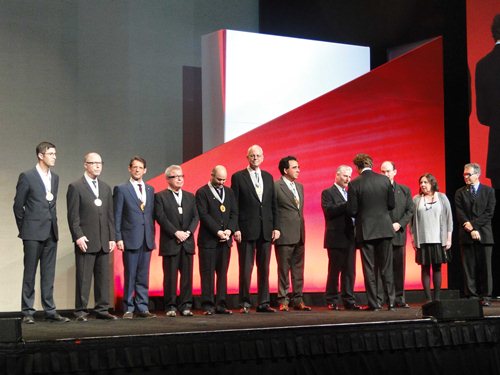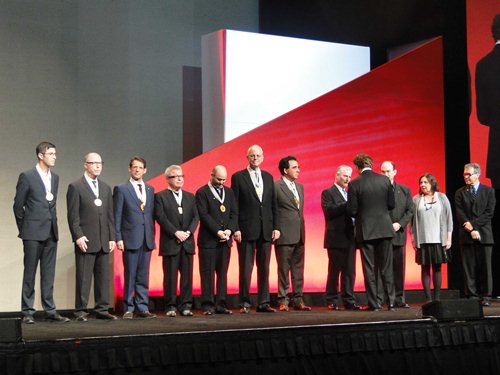by: admin

(l-r) Michael Arad, AIA, LEED AP; Robert I. Davidson, FAIA; Steven M. Davis, FAIA; Daniel Libeskind, AIA; Craig E. Dykers, AIA; David M. Childs, FAIA; Santiago Calatrava, FAIA; Joseph Aliotta, AIA; Jeffery Potter, FAIA; William T. Brown, AIA; Debbie Burns, Hon. AIA; Rick Bell, FAIA
Daniel Fox
Event: Architects of Healing: Honoring the Architects Involved in Post-9/11 Memorial and Rebuilding Efforts
Location: Walter E. Washington Convention Center, Washington, DC, 05.19.2012
Speakers: Robert I. Davidson, FAIA, senior vice president, STV; Daniel Libeskind, AIA, principal, Studio Daniel Libeskind; David M. Childs, FAIA, chairman emeritus, Skidmore Owings, & Merrill; Michael Arad, AIA, LEED AP, partner, Handel Architects; Craig E. Dykers, AIA, senior partner/director, Snøhetta; Steven M. Davis, FAIA, partner, Davis Brody Bond; Santiago Calatrava, FAIA, principal, Santiago Calatrava LLC; Robert Ivy, FAIA, executive vice president and chief executive officer, AIA (introduction); Jeffery Potter, FAIA, 2012 AIA President (moderator)
Organizers: AIA 2012 National Convention
The theme of this year’s national AIA convention, “Design Connects,” can have multiple meanings. The concluding keynote, assembling the architects responsible for the various components of the rebuilding of Ground Zero for both ceremony and substance, connected the nation’s architects with New York’s experience and the specific task of rebuilding Lower Manhattan with architecture’s universal mission. “The attacks were not against a building; the attacks were against our freedom, our values,” said Steven Davis, FAIA, whose firm Davis Brody Bond had been engaged with the site since 1992, and whose master plan documents proved invaluable during the response to the initial World Trade Center bombing in 1993. Yet in concrete reminiscences of the events of 9/11 and in moments of somber eloquence about what was lost at the WTC, Shanksville, PA, and the Pentagon – and what was found to be immune to loss – the speakers also emphasized that connections between buildings and values are indissoluble.
After an arresting reading by AIA EVP/CEO Robert Ivy, FAIA, about his immediate experiences of 9/11, the seven honorees (each introduced by a brief video) testified to the overwhelming responsibility and privilege of working on this site. Rebuilding downtown has required an unprecedented combination of gravity, creativity, and collegiality; those recognized here were scrupulous about sharing credit with teammates and honoring the fallen. David Childs, FAIA, appropriately echoed earlier comments by historian David McCullough and Gold Medal recipient Steven Holl, FAIA, respectively, that “all great work is a joint effort” and “architecture is all about collaboration.” (It is no accident that the honorees, for all the patriotic flavor of the proceedings, are a hybrid, hyphenated, international crew. Healing a wounded city takes more than a local community or even a nation; it takes a planet.)
Memories of the emotionally charged atmosphere just after 9/11 may have blurred slightly over a decade, but they remain ineradicable. Restoring essential infrastructure in the wake of the atrocity, recounted Robert Davidson, FAIA, took a heavy personal toll, but also called forth enormous reserves of determination. He singled out Port Authority architect Russell Kriegel, AIA, who overcame nearly paralyzing grief and responded to Davidson’s appeal (“take the weekend, but I need you”), reporting back ready to work on the temporary PATH Intermodal Station, which became the first public facility to reopen at the site, beating its timetable and winning awards as well as relieving the enormous transportation bottleneck caused by PATH’s closure. Daniel Libeskind, AIA, traced his progress as an immigrant drawn by America’s ideals; returning to New York from Berlin after his Jewish Museum had opened the same day as the attack, he devised the master plan whose key details (the descent to bedrock, the preserved slurry wall, the towers’ spiraling gesture toward the Statue of Liberty) remain physically and metaphorically evocative even after a decade of negotiation and revision. These ideas do more than transform “a piece of real estate” into something greater: they strengthen New Yorkers’ connections to the values of tolerance and steadfastness, “the best of America” as this American-by-choice sees it.
Visiting another great civic space, said Michael Arad, AIA (another American-by-choice), strengthened his appreciation of urban community. Biking to Washington Square Park in the days after the attack, he found fellow New Yorkers around the fountain sharing their memories and their resolve. “For the first time I felt at home in New York,” proud of his adopted heritage, and grateful for the opportunities it affords; this appreciation of what public plazas can do to catalyze people’s civility, solidarity, and resilience informed his design of the “Reflecting Absence” memorial. A parallel commitment to built forms supporting free expression appeared in the comments of Snøhetta’s Craig Dykers, AIA, whose initial reluctance to intervene at Ground Zero was overcome by his intrigue with “the idea that New Yorkers had the courage to place a cultural building directly on the memorial,” and by the persistent appeals of his friend Denzil Gallagher of Buro Happold. “We experienced the best and worst of humanity in a single day,” Dykers observed; in the 9/11 Memorial and Museum Pavilion that emerged from the troubled negotiations over the “messy proposition” that culture and memory could share this space, Snøhetta unites another pair of opposites – the retrospective view of the memorial complex and the future life of these facilities in a vibrant city – through forms that amplify the energy of the present. Watching a family’s recent photo opportunity, using the Pavilion’s mirrored surface to shoot themselves rather than asking a stranger to take the shot, Dykers said: “It was then I felt it was all worthwhile.”
Santiago Calatrava, FAIA, was in Athens on September 11, mesmerized like most world citizens by the broadcast images of destruction. Here, he connected modern civic infrastructure with antiquity, referring to the rebuilding of the Acropolis after Athens was invaded in the fifth century B.C. and the subsequent Golden Age of Greek civilization, when arts flourished and democracy took its early form. “The columns of the original Parthenon were saved and reused to buttress the walls of the new Acropolis,” he noted. “To me, these columns link the tragedy and triumph of ancient Athens, and testify to Man’s innate capacity to overcome such events.” Likewise, today’s rail stations and bridges do more than serve literal functions within a transportation system; they have “enormous symbolic value. As gateways, they are the first and last places we experience when entering and leaving the city,” and for hundreds of thousands of people daily, the new Transportation Hub will add dignity to those movements as well as ease.
“Democracy requires bravery,” commented Childs in one of the videos. Bravery appeared rapidly in democracy’s defense on Flight 93; bravery of a different sort, operating on a longer timetable, distinguishes everyone who has labored on the World Trade projects. Bravery, perseverance, and other virtues, long after the moments when they come into play, can elicit such a rhetoric of uplift that a listener is paradoxically overcome by its weight – yet there is something about this site, and the efforts to renew it (now gradually reaching fruition), that overwhelms a dissonant response. A concluding salute by the Cathedral Choral Society and a full stage of honorees, including Joe Aliotta, AIA, LEED AP, AIANY’s president and Rick Bell, FAIA, AIANY’s executive director, and the architects involved with the Shanksville and Pentagon memorials, brought a standing ovation, uninhibited and unforced.
Bill Millard is a freelance writer and editor whose work has appeared in Oculus, Icon, Content, The Architect’s Newspaper, and other publications.










